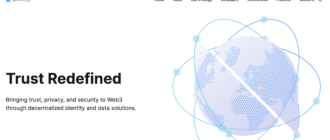Biconomy is a pioneering blockchain project focused on enhancing decentralized applications (dApps) by improving their user experience with transaction relayers and multi-chain infrastructure. The platform aims to solve the perennial issue of complex blockchain interactions which often deter non-technical users from adopting blockchain technology.

History of the Project
Founded in 2019, Biconomy was born out of a need to simplify user interactions with decentralized technologies. The founding team, consisting of seasoned blockchain developers and entrepreneurs, aimed to bridge the gap between blockchain technology and user-friendly applications. Since its inception, Biconomy has evolved, marked by significant milestones such as the launch of its native token, BICO, and strategic partnerships across various blockchain ecosystems.
What is Biconomy
Biconomy is a multi-chain relayer protocol that aims to reduce the friction between blockchain interfaces and end-users. It addresses issues such as high gas fees, slow transaction times, and the complexity of multi-step transactions by providing a transaction infrastructure that enables developers to create more accessible and user-friendly dApps.
How Biconomy Works
Biconomy leverages a unique set of blockchain technologies and innovations designed to optimize the interaction between users and decentralized applications (dApps). At its core, Biconomy focuses on reducing the complexity and costs associated with blockchain operations, setting itself apart through a combination of relayer networks, smart contract operations, and its own native blockchain components.
Relayer Networks
A cornerstone of Biconomy’s infrastructure is its use of relayer networks. These networks facilitate transactions on behalf of users, enabling what are known as meta-transactions. This means that end-users do not need to hold native blockchain tokens to pay for gas, which is typically a barrier to entry. Instead, transactions are processed by relayers who pay the necessary fees, and then get reimbursed in BICO tokens, plus a fee for their services. This system not only simplifies the user experience but also enhances transaction throughput by decentralizing the load across multiple relayers.
Hyphen Technology
Hyphen is Biconomy’s proprietary technology for instant, low-cost cross-chain transactions. It works by maintaining liquidity pools on various blockchains, which allows for quick transfers that bypass the slower, more traditional blockchain confirmations. This system is particularly beneficial for users who interact with multiple blockchains, as it minimizes the wait times and fees typically associated with cross-chain transfers.
Blockchain and Consensus Mechanism
Unlike many projects that rely on existing blockchain infrastructures like Ethereum, Biconomy has developed its own blockchain designed to specifically support its relayer and multi-chain architecture. This blockchain operates using a Proof of Stake (PoS) consensus mechanism, which is less energy-intensive than Proof of Work (PoW) and allows for faster transaction validation.
The Biconomy blockchain is distinctive because it integrates directly with the relayer network, creating a seamless interaction layer. Validators in this blockchain are also stakeholders in the network, incentivized through transaction fees and governance tokens to maintain network integrity and security.
Smart Contract Layer
Smart contracts on Biconomy are designed to be modular and reusable, which significantly reduces the development time for dApps. They handle various functions such as managing relayer fees, user permissions, and interactions across different blockchains. The smart contracts are also upgradable, ensuring that the network can adapt to changes in the blockchain landscape or user requirements without undergoing a complete overhaul.
Unique Differentiators
What sets Biconomy apart from other projects is its dual focus on user experience and developer accessibility. Its technology stack not only addresses the user-facing issues such as gas fees and multi-chain complexity but also provides developers with tools to build more efficient and user-friendly dApps. The integration of a proprietary blockchain and a tailored consensus mechanism further allows Biconomy to optimize its network to serve its specific needs, rather than depending on the limitations of general-purpose blockchains.
Tokenomics of Biconomy
The Biconomy ecosystem is powered by the BICO token, which serves several critical functions within its network architecture. BICO is a token, not a coin, as it is built on the Ethereum blockchain as an ERC-20 token and designed to facilitate operations within the Biconomy ecosystem rather than acting as a standalone currency.
Token Utility and Functions
BICO’s primary utility is to enable the transaction relaying process, where users can engage with dApps without needing to pay gas fees in the native currency of the blockchain they are interacting with. Here, BICO is used to compensate relayers who pay the gas fees on behalf of the users. Additionally, BICO is utilized for governance, allowing token holders to vote on key network decisions and protocol upgrades, ensuring a decentralized governance structure.
Emission Model and Distribution
Biconomy implemented an emission model for BICO with a fixed supply cap of 1 billion tokens, which means no additional BICO will be created once this cap is reached. The distribution of these tokens was planned as follows:
- 20% to the community through mining rewards and incentives.
- 25% reserved for the team and future employees, subject to vesting periods to align team incentives with the long-term health of the project.
- 10% allocated to investors and advisors with specific lock-up and vesting conditions.
- 45% dedicated to ecosystem development which includes funding future developments, partnerships, and community initiatives.
Token Value and Market Dynamics
The value of BICO is not only reflective of market demand but is intrinsically linked to the usage rates of the Biconomy network. As more dApps integrate Biconomy’s relaying services, the demand for BICO increases, which in turn can increase the token’s value. Additionally, the tokenomics are designed to reduce available supply over time through various burning mechanisms during transaction processing, potentially leading to deflationary pressure on the token.
Current Market Position
As of the latest data, BICO has experienced varying levels of volatility, typical of many crypto assets. Its value depends heavily on the broader market sentiment, developments within the Biconomy ecosystem, and adoption rates by both users and developers.
Where to Buy BICO Token
BICO tokens can be purchased from several major cryptocurrency exchanges, ensuring that they are accessible to a broad audience worldwide. Here is a list of platforms where BICO is currently available:
- Binance: As one of the largest and most popular cryptocurrency exchanges globally, Binance offers robust trading options for BICO, including spot and futures markets.
- HTX (formerly Huobi): HTX is known for its extensive range of crypto assets, and BICO is included in its trading pairs, offering another reliable platform for acquiring these tokens.
- MEXC: Known for its user-friendly interface and strong customer support, MEXC provides another venue for trading BICO, catering to both beginners and experienced traders.
- Bybit: Bybit has emerged as a significant player in the crypto derivatives market but also offers spot trading for tokens like BICO.
- KuCoin: This exchange is celebrated for listing a wide variety of cryptocurrencies, including newer and less known tokens like BICO, making it a good choice for diverse trading options.
These exchanges are chosen based on their reliability, security features, and the ease of trading they offer to users looking to buy and sell BICO.
Where to Store BICO Token
When it comes to storing BICO tokens, users have several options that cater to different needs regarding security, accessibility, and user experience. Here are some recommended wallets:
- MetaMask: Although primarily known for Ethereum, MetaMask can also store any ERC-20 compatible tokens, including BICO. It’s widely used due to its ease of integration with most decentralized applications.
- Trust Wallet: This mobile wallet supports a vast range of cryptocurrencies including ERC-20 tokens like BICO. It offers an easy-to-use interface and secure storage for your tokens.
- Ledger Nano S/X: For those seeking higher security, Ledger Nano hardware wallets provide an excellent option. They support the storage of BICO by keeping the tokens offline and secure from online threats.
- Trezor: Another hardware wallet option, Trezor, offers robust security measures and supports a wide variety of digital assets, including BICO tokens.
- MyEtherWallet (MEW): MEW allows users to interact with the Ethereum blockchain directly and supports all ERC-20 tokens, including BICO. It can be used as a web wallet or in conjunction with hardware wallets for enhanced security.
Choosing the right wallet depends on the user’s preference for security versus convenience. Hardware wallets like Ledger Nano and Trezor provide the highest security level as they store tokens offline. In contrast, software wallets like MetaMask and Trust Wallet offer more convenience and faster access to funds, suitable for those frequently trading or using tokens on various dApps.
Future Prospects and Development Forecast
Biconomy’s growth prospects are anchored in its innovative approach to solving significant usability challenges in blockchain applications. Its potential expansion is closely tied to its ability to maintain and extend strategic partnerships and its consistent focus on enhancing the user experience in blockchain interactions.
Client and Partner Base
Biconomy has strategically positioned itself as a critical service provider for decentralized applications (dApps) seeking to improve user experience and manage transaction costs effectively. Its clients typically include dApp developers across various sectors such as finance, gaming, and decentralized autonomous organizations (DAOs).
Key partnerships that have been instrumental in the growth of Biconomy include:
- Decentraland: By integrating with Biconomy, Decentraland allows users to engage with its virtual reality platform without worrying about gas fees, enhancing user retention.
- DAOstack: This partnership enables DAOstack to offer its users smoother interactions by minimizing the transaction costs and complexities typically associated with DAO operations.
- Perpetual Protocol: Biconomy helps in streamlining the trading experience by handling transaction relays, thus reducing the barrier for new users entering the decentralized finance (DeFi) space.
These collaborations not only expand Biconomy’s user base but also enhance its visibility and credibility within the blockchain ecosystem.
Development Forecast
Looking ahead, Biconomy is expected to focus on expanding its multi-chain capabilities to include more blockchains, which will likely increase its market penetration and utility. The development of more advanced relayer algorithms and the potential integration of AI for predicting transaction costs could position Biconomy at the forefront of blockchain infrastructure services. Furthermore, as the ecosystem around decentralized applications grows, the demand for Biconomy’s services is expected to rise, correlating directly with the growth in dApp usage.
Biconomy Ecosystem
The Biconomy ecosystem is designed to be robust, catering to a wide array of needs within the blockchain community:
- Relayer Network: At the heart of its ecosystem, this network enhances transaction efficiency and user experience.
- Hyphen: Provides fast and affordable cross-chain transactions, which are crucial for users interacting with multiple blockchains.
- Developer Tools: Biconomy offers a suite of APIs and SDKs that enable developers to easily integrate its features into their applications, reducing entry barriers for new and existing developers.
By continuously developing and expanding this ecosystem, Biconomy not only solidifies its current market position but also enhances its future growth potential. The ongoing innovation in its core technologies and strategic partnership efforts are key indicators of its trajectory towards becoming a leading solution provider in the blockchain space.
Conclusion
Biconomy stands out in the blockchain space with its user-centric technologies that tackle some of the most challenging issues faced by the decentralized world. Its potential for fostering broader adoption of blockchain technology makes it a project worth watching for advanced users and investors looking for strategic opportunities within the crypto space. With its strong foundation and innovative solutions, Biconomy is well on its way to becoming a key player in the blockchain infrastructure landscape.






